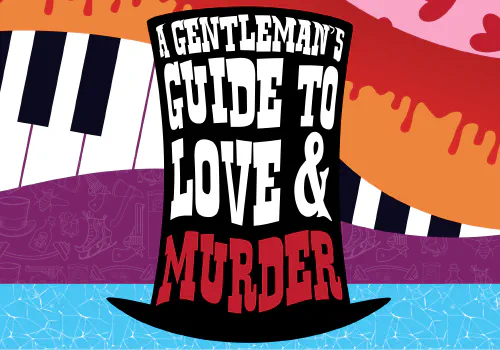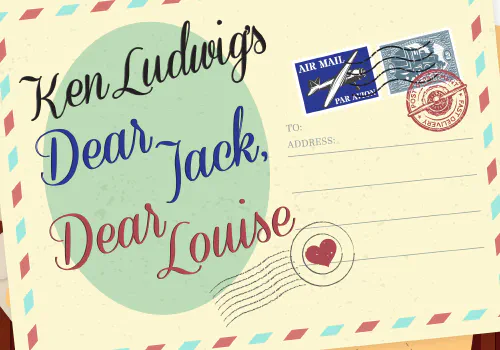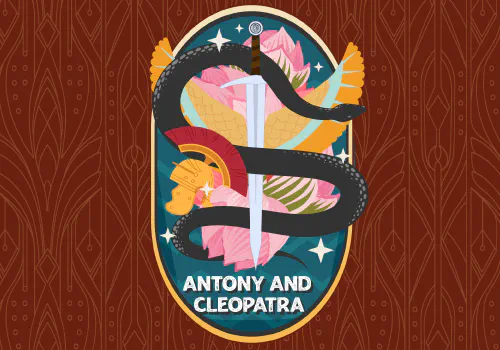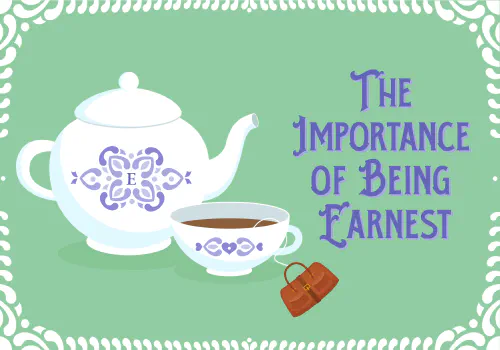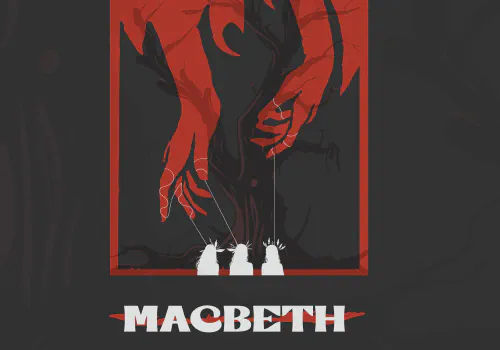Meet Rodgers and Hammerstein
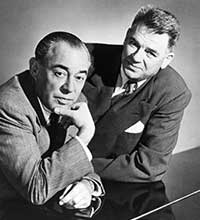
By Lisa Larson
As the opening notes of the Utah Shakespeare Festival’s production of The Sound of Music swell to fill the theatre, audiences will be swept away to the mountains of Austria and the final golden days of the 1930s. But it is not only the poignant story of the Von Trapp family that makes this production so beloved. Rather, it is the masterful minds of two duos—four men—that each had a hand in turning this remarkable piece of history into a story that lives in hearts and minds from generation to generation.
In essence, the hills—and theatres around the world—are alive with the sound of their music.
Richard Rodgers, Oscar Hammerstein II, Howard Lindsay, and Russel Crouse each played a part in bringing the story of Maria and the Von Trapp children to life. Yet, as remarkable as The Sound of Music is, it is only one of many contributions each of these men shared with the world.
Richard Rodgers
Born in Arvene, New York in 1902, Richard Rodgers came into a home that valued music and exposed Rodgers to theatre from a young age. The son of a physician father and amateur musician mother, Rodgers started plucking at the piano at age four, (https://www.pbs.org/ wnet/ broadway/ stars/ richard-rodgers/). By age six he was playing piano by ear. At ten he wrote his first song, “My Auto Show Girl.”
Rodgers continued cutting his musical teeth on compositions for amateur boys’ club shows. According to NotableBiographies.com, Rodgers felt his early exposure to operettas by Victor Herbert and others were extremely influential. He also said that musicals by Jerome Kern left a “deep and lasting” impression.
During his time at Columbia University, he began the first of two long-term professional partnerships, first with Lorenz Hart. Rodgers and Hart’s work on the 1919 Fly with Me proved to be their introduction to the world as a musical duo (https://www.britannica.com/ biography/ Richard-Rodgers). The partnership lasted twenty years until Hart could no longer work.
“What actually brought about (the end of Hart and Rodgers’ partnership) was Larry’s disintegration,” Rodgers said in an interview with American Musical Theater WCBS in 1961 (https://www.youtube.com/ watch?v=YVa6W2QOW64). “Larry started to fall apart at a much too early age.” Seeing the inevitable decline of his friend and writing partner, Rodgers knew he needed to make a change in order to continue in his career. His mind turned to the well-known American lyricist Oscar Hammerstein II.
Oscar Hammerstein II
The grandson of well-known opera impresario Oscar Hammerstein, Oscar Hammerstein II—known as “Okie” to friends—was born in New York City in 1895. Hammerstein came by his love of theatre naturally, almost biologically, as his father was a successful vaudeville actor, his grandfather an opera star, and his uncle Arthur the producer of Broadway musicals. However, his father pushed him to study law at Columbia University, which he did for a time. But soon, his passion for theatre won out (https://www.biography.com/ musician/ oscar-hammerstein-ii).
Hammerstein found a place for his passion among the Varsity Theater shows at Columbia University, including the 1915 review On Your Way. Later, he worked for his Uncle Arthur as an assistant stage manager but was quickly promoted to production manager for all of Arthur’s shows. Among Hammerstein’s notable successes, it was his work with Jerome Kern on the 1925 musical Showboat that firmly established his reputation as a writer and lyricist to be reckoned with (https://www.pbs.org/wnet/ broadway/ stars/ oscar-hammerstein-ii/).
However, even with all the accomplishments in his early career Hammerstein is purported to be very aware of the times when his efforts didn’t set sail as majestically as Showboat did. “One of the tough things has been to endure failure. And I’ve endured a lot of it,” Hammerstein said (https://www.biography.com/ musician/ oscar-hammerstein-ii).
Many might look at the lengthy list of accomplishments, awards, and accolades and wonder at Hammerstein’s definition of “failure.” But his career—while peppered generously with monumental successes, also included his fair share of setbacks. For example, in 1919 he wrote his own play called The Light, produced by his Uncle Arthur, but it never really grew legs enough to move it along, according to Biography.com. Despite that setback, Hammerstein soldiered on; forging ahead in his writing to collaborate with Rodgers and Hart on the 1920 Fly with Me.
Hammerstein’s influence through the years was felt by many, including another well-known lyricist, Stephen Sondheim (Sweeney Todd, West Side Story). According to the PBS.org article, Sondheim was a friend of the Hammerstein family and credited much of his success to Hammerstein’s influence.
Rodgers and Hammerstein: Even Better Together
When the time came to seek out a new partnership, both Rodgers and Hammerstein were ready to work together. Even if they had no idea the success they would become.
According to an interview with Rodgers on WCBS in 1961 (https://www.youtube.com/ watch?v=YVa6W2QOW64), it was Rodgers who approached Hammerstein about working together on Oklahoma. “Oscar and I had met physically, when we were very small children because my father was a doctor and he was the obstetrician who delivered Oscar’s first two children,” Rodgers said in the WCBS interview. “Oscar even married a second or third cousin of mine. I always knew Oscar when he was a young man in college and I was a young man in high school.”
When Larry Hart was no longer able to work, Rodgers approached Hammerstein. “He said, I accept your proposal of marriage,” Rodgers said, with a laugh.
In another interview (https://www.youtube.com/ watch?v=k4ypJhDS19I), Rodgers affirmed his dedication to the decision despite Hammerstein’s several professional setbacks. “I had tremendous faith in Oscar,” Rodgers said. “I knew beyond argument about his enormous talent. . . . this was the logical direction for me to go in.”
And he was right.
In the course of their seventeen years together, Rodgers and Hammerstein’s partnership yielded such beloved classics as Oklahoma (1944), Carousel (1945), South Pacific (1949), The King and I (1951), Pipe Dream (1955), Flower Drum Song (1958), and, of course, The Sound of Music (1959). Clearly the impact Rodgers and Hammerstein had on the world of musical theatre cannot be overstated.
Hammerstein’s task with Rodgers was to “combine bright tunes with relatively sophisticated stories—a blend then-unfamiliar to the stage, but later widely adopted.” (https://www.britannica.com/ biography/ Oscar-Hammerstein-II). So it’s not just the unforgettable music this duo composed, but the impact their style had on the development and direction of musical theatre forever after.
Howard Lindsay and Russel Crouse
As for the second duo behind the masterful The Sound of Music, Howard Lindsay and Russel Crouse is a story of a twenty-eight-year partnership in writing, producing, and theatre management that included producing greats such as The Sound of Music, as well as Anything Goes with Cole Porter, Call Me Madam with Irving Berlin, and more.
Crouse, whose father was a newspaperman, worked as a reporter for the Cincinnati Commercial Tribune at age seventeen. Later he worked for the Kansas City Star as a sports reporter, traveling extensively for his work (https://www.masterworksbroadway.com/artist/howard-lindsay-and-russel-crouse/).
Crouse made his Broadway debut as an actor in 1928. Then in 1931 he started writing for the stage, collaborating with Oscar Hammerstein on The Gang’s All Here.
Meanwhile, Lindsay graduated from Boston Latin School in 1907 and spent a year at Harvard before the war. He acted in shows like Sweet Nell of Old Drury and began to establish his directing credentials. His first play was Tommy in 1927, which was produced on Broadway for 232 performances. The show was later made into a movie in 1932 called She’s My Weakness, according to Masterworks Broadway.
Both Lindsay and Crouse continued to work in theatre independent of the other before crossing paths to re-write a script called Bon Voyage. The story, originally told about a cruise ship that wrecks off an island paradise, was in need of a new look after a real-life shipwreck made it difficult to move forward with the rehearsals. At the hands of Lindsay and Crouse it became the now famous, Anything Goes, according to the MasterworksBroadway.com article.
As a duo, their fame and fortune solidified after their involvement with a dramatization of stories from Clarence Day Jr. in 1939 known as Life with Father. According to MasterworksBroadway.com, the show still holds the record for the longest running non-musical play on Broadway with 3,224 performances.
Lindsay and Crouse owned and operated a theatre—the Hudson on 44th Street—for several years. Their initial production in the theatre, Arsenic and Old Lace in 1941 was a smashing success, putting their theatre on the map (https://www.masterworksbroadway.com/artist/howard-lindsay-and-russel-crouse/).
It wasn’t all hits and successes though. But once again, perseverance paid off. After coming off of a disappointing turnout for the adaptation of Howard Nemerov’s The Homecoming Game turned into Tall Story for Broadway, Lindsay and Crouse hit the mark with the book for The Sound of Music starring Mary Martin, Theodore Bikel, and Patricia Neway. The show ran for 1,443 performances between 1959 and 1963 and later became the amazingly popular movie in 1965 starring Julie Andrews.
Shortly after the premiere of the film version of their crowning success, Crouse died of pneumonia at age seventy-three, ending the longest running collaboration of any writers in theatrical history — more than twenty-eight years, according to Masterworks Broadway.
The film version of The Sound of Music reigned for five years as the highest grossing film in history, nominated for ten Academy Awards and winning five (https://www.britannica.com/topic/The-Sound-of-Music-film-by-Wise).
Such an epic success does not come without a multitude of stories behind the scenes, each person with their own mountains to climb and favorite things to share, all so that audiences can make The Sound of Music part of their musical experience.


